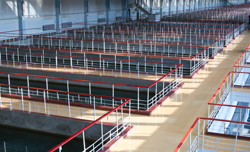Municipal and Industrial drinking water purification

Open gravity drinking water filters
In recent years the presence of potential endocrine disrupters in drinking water has become an important topic and activated carbon has an important and developing role in this area too.
Drinking water that is to be treated needs to be tested first to determine types and concentrations of contaminants and thereby select the most effective treatment methods. If activated carbon is required, the type will be influenced by the type of impurities that need to be removed from the water and the type of water to be treated (surface water, groundwater or bank infiltrate). Coal, coconut and wood based carbons are all used in water treatment.
Activated carbon is used in many public and industrial drinking water treatment works as one of the stages, where necessary depending on the prevailing water quality and types of contaminants present. It may either be used in powder form, in a dosing system, or in permanent beds of granular carbon. Powder dosing may be needed during periods where higher concentrations of contaminants are present for whatever reason.
When the activated carbon is saturated or the treatment objective is reached, spent activated carbon may be replaced and removed from the process for recycling by thermal reactivation in dedicated high temperature furnaces.

Activated carbon in your daily life
